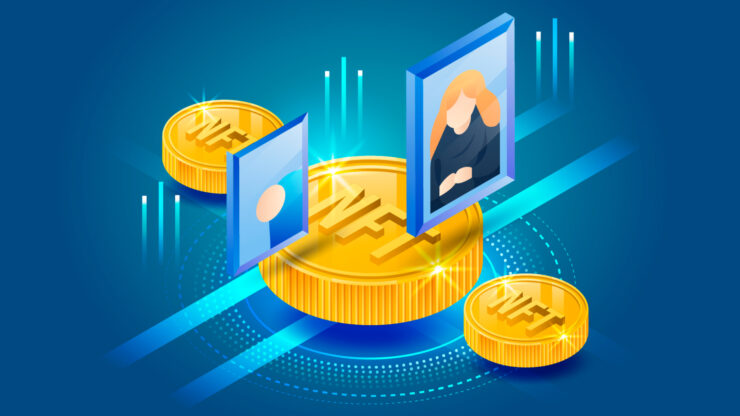NFTs are a way to break into cryptocurrency. They act as digital assets, which people can buy and sell using interfaces called crypto wallets. Buying something with cryptocurrency means creating a crypto wallet. You can think of this crypto wallet as a bank account where you store your NFTs, without the interest rates, of course.
These accounts issue you with a unique string of letters and numbers that you can use to buy cryptocurrencies and receive funds from other people who want to send you cryptocurrencies or NFTs.
Bitcoin is a household name by now, but there are other options like Ethereum and Dogecoin. Ethereum is a currency that’s risen in popularity thanks to its NFT capabilities, but other cryptocurrencies and companies like Etsy have also gotten into the NFT game with their own variations on the concept.
Cryptocurrencies are an Exciting Method of Payment

Cryptocurrencies are exciting. It’s an entirely new method of payment that’s been gaining popularity over the last decade. The market for these digital currencies is fairly new, and it’s super interesting to follow the ongoing developments.
Cryptocurrency is a pretty unique way to exchange value, and it works in a completely different way than cash or credit cards, although you can buy crypto with a credit card. You can visit okx.com to learn how. This is because cryptocurrency is not cash—it does not physically exist. However, if the need arises you can choose to convert crypto to fiat AKA good old fashioned cash.
But it also doesn’t work like traditional credit card transactions—when you use your credit card to make a purchase, your bank transfers money from your account to the merchant’s account through some sort of virtual ledger. Cryptocurrency transactions are recorded on blockchain ledgers instead of bank-run ledgers, which means they occur outside the realm of banks altogether.
The biggest difference between cryptocurrencies and other methods of payment is that cryptocurrencies are anonymous. You may have heard this referred to as “pseudonymous” — where only pseudonyms are used — but either way, this anonymity factor makes them attractive to many people who don’t want their financial activity tracked by banks or governments.
The other big difference with crypto payments is that they do not require intermediaries like Visa or MasterCard; if you want to transfer cryptocurrency from one person’s wallet to another (which you can do fairly easily), all you need is their “public key,” found in their digital wallet app or online wherever else they store their private keys (we’ll discuss private keys soon). And when someone sends a minute’s worth of bitcoins back? Their transaction history stays there forever – unless deleted manually from the blockchain explorer website by sending more bitcoins into their address, it’s still being explored!
The Non-Fungibility of Cryptocurrencies Enables their use in Diverse Ways

Cryptocurrencies are digital currencies that go unregulated by a central authority, nor are they backed by any commodity. Instead, the value of a cryptocurrency is determined by the demand for its use in transactions. Cryptocurrency transfers take place through a blockchain, a decentralized ledger.
The non-fungibility of cryptocurrencies enables their use in diverse ways. The most common one is as an instrument of exchange—cryptocurrencies can be used to make peer-to-peer transactions without involving banks or other financial institutions. But that’s just the tip of the iceberg! Cryptocurrencies have also been used as investments and storehouses of value; they’re even being looked at as possible forms of payment for things like real estate and luxury cars.
Crypto Art is Gaining Popularity and Selling for High Prices
You’ve probably heard of NFTs and their potential to help you make money on crypto. But have you seen crypto art? It’s a combination of crypto and art—cryptocurrency meets fine art, if you will. The concept is simple: Crypto art is made from digital files and then sold as digital assets or NFTs. In other words, rather than going through the hassle of buying fine art and having to physically store it somewhere, you can buy a piece of crypto art online at superrare.com instead.
Each piece of crypto art has its own private key that’s linked to an NFT on the blockchain. When someone buys your work (for anywhere from a few hundred dollars to more than $1 million), they receive the private key that links to that unique copy on the Ethereum blockchain.
They also get what’s known as the “original work file”—the JPEG file they can use for personal enjoyment—but they do not own it. That ownership remains with the seller (or whoever owns the private key). The buyer is simply licensing it from them (which means they don’t control who can resell it or even how many times it gets resold).
NFTs have Proven their Worth through Record Sales
As the market continues to mature, we see more and more use cases emerge. Non-fungible tokens are being sold for millions of dollars, with some valued at over $1 million apiece. One of the first NFTs ever sold was called “CryptoPunks,” and it sold for over $6.6 million in February 2024.
Other NFTs are selling for even higher prices keeping up with a wider trend of mainstream adoption. In one case, an NFT sold for 300 ETH (Ethereum), which is equal to around $69 million as of this writing.
NFTs are a Method of Owning Unique Items
Non-fungible tokens are a great way to authenticate and exchange collectibles in the digital space. They are bought and sold on blockchain-based marketplaces that allow users to purchase ownership of digital versions of everything from trading cards to rare artwork. Unlike their fungible counterparts—the most famous being Bitcoin—NFTs can’t be replicated or exchanged for other items. Each token is unique because it exists as a uniquely identifiable record in the blockchain ledger.
It’s not just games where these tokens play a part in transactions; they’re also commonly used by artists who want to sell art online, such as music recordings and animated GIFs. If you’ve heard about “that” Beeple art sale earlier this year, then you already know what an NFT looks like—and how valuable it can be!
NFTs are a Profitable Way to Invest in Digital Works of Art

NFTs are more than a passing fad. If you’re searching for paths to diversify your investment portfolio, NFTs present a lucrative opportunity. Not only can you purchase unique digital assets for a fraction of what it costs to buy the physical edition, but you can also invest in NFTs as art collectors do.
But what is an NFT? NFT stands for Non-Fungible Token, which means that each piece of work is entirely unique and cannot be traded in exchange for other pieces of work on any decentralized marketplace.
NFTs Open up Lucrative Investment Opportunities for Digital Artists and Designers
Some cryptocurrency enthusiasts see NFTs as a way to earn a return on investment or ROI. For example, if you buy an NFT for a piece of digital art for $50 and that artwork later increases in value to $100, you can sell it for a higher price and make a profit. NFTs are also unique because they offer new ways to invest in digital artwork. Unlike traditional stocks and shares that allow you to invest in companies or commodities like gold or oil, you can use NFTs to own pieces of digital art.
At the heart of NFTs is their non-fungibility. If you’ve never heard that term before, it refers to something being unable to be substituted for another thing of the same type. For example, money is fungible because any $100 bill can be exchanged for another, and it wouldn’t make a difference in value. It’s not true with NFTs—a specific token bought for 100 Ether (ETH) cannot be swapped for someone else’s token bought at 100 ETH, even if they’re both exactly the same. Why? Because no two tokens are actually identical, each one has its own unique history.
Non-fungibility adds value to NFTs because it makes them unique and gives each one a story. The blockchain ledger also helps increase their value by creating an immutable record of who owns them and how they were transferred between owners over time, giving each token its own independent digital footprint that comes with ownership rights.
The non-fungibility and traceability of blockchain technology mean NFTs can be used as a ‘store of value.’ In other words, they have enough inherent worth that you could use them as collateral for future credit if needed—and you’ll always know where your collateral came from because it lives on the blockchain.”
Related Posts:
- 20 Best Gaming Headset Under 50$ 2024 - for PC, PS4,…
- Top 10 Best Scrubs For Women 2024 - Pants for Nurses…
- 10 Best External Hard Drive 2024 - Compatible With…
- Top 10 Best Power Inverter for Car 2024 - Keep Your…
- Top 10 Best Inflatable Kayak 2024 - for Exploring…
- Top 10 Best Office Chair Under 200 2024 - Ergonomic…







